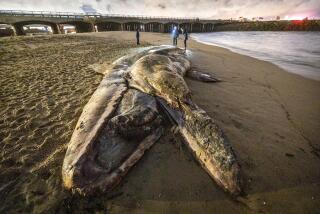The more humans spread, the smaller other mammals get. Elephants, rhinos and hippos had better watch out

- Share via
Thirteen thousand years ago Southern California was crawling with enormous mammals — all of which are extinct today.
There were massive mammoths three times bigger than modern-day elephants, giant ground sloths up to 20 feet in length, and strange, armadillo-like beasts known as glyptodons that were roughly the size of a VW bus.
And don’t forget the llamas, camels, dire wolves, cave lions and saber-toothed cats that all called SoCal home as well.
Today, the largest local land mammal is the bighorn sheep, which weighs about 300 pounds.
And a similar trend can be found on all the continents of the planet.
Over the past 100,000 years, the mean body mass of mammals in Eurasia dropped by 50% and by an order of magnitude in Australia. More recently, there was a tenfold drop in the average size of mammals in the Americas.
So, what led to this dramatic shift in mammal size worldwide?
According to a study published Thursday in Science, the answer is us.
“When we look at the fossil record, what we find is that every time hominids get to a new continent there is an extinction event, and that extinction is always large-bodied animals,” said Felisa Smith, a paleoecologist at the University of New Mexico, who led the work.
Her research also revealed that if this pattern continues, in a mere 200 years the largest land mammals left on Earth will be the size of a domestic cow.
“And it shouldn’t escape your notice that we take care of cows,” she added. “If they survive, it’s because we want them here.”
Scientists have long known that the big land mammals were the first to disappear in extinction events that occurred in the past 125,000 years, but there was disagreement about why that might be the case.
Some argued that the biggest animals may have been more susceptible to changes in climate or the environment. Others thought the increasingly skilled hunting prowess of Homo sapiens was the culprit.
What Smith and her colleagues found is that it wasn’t just our own species that was responsible for these global changes in animal size; instead, it was the rise and dispersal of hominids in general.
“We are not the only species of homos that ever hunted,” she said. “Homo erectus, Homo heidelbergensis, Neanderthals and Denisovans all used tools and hunted as far as we know.”
For this study she set out to discover what effect on mammal-size hominids as a group had, and whether it could be detected.
Her first step was to look at the fossil record going back 125,000 years to see if the extinction of large mammals on the various continents coincided with when the first hominids arrived there.
This line of inquiry revealed that mammal body mass did indeed drop dramatically when hominids arrived in in Eurasia around 100,000 years ago, when they arrived in Australia around 60,000 years ago and when they migrated to the Americas around 13,000 years ago.
In addition, she found that the extinction events were swifter and more dramatic as time went on. The extinction event was slow and long in Eurasia, and much speedier and deadlier in the Americas. This suggests that as humans developed more advanced weaponry, they were more effective at eradicating large animals quickly, she said.
A slightly different story came to light in Africa, however, where the largest mammals on Earth reside today. According to the fossil record, the mean size of African mammals 125,000 years ago was roughly 50% smaller than you would expect, based on the size of the land mass they inhabited.
Smith and her colleagues conclude that the size of large mammals on that continent may have been affected by hominid hunters going back more than a million years.
“There was a long history of hominids and megafauna interaction in Africa,” Smith said. “This finding suggests there was already an impact on animal size at this time.”
To confirm the hypothesis that the decrease in mammal size was directly related to hominid influence and not other factors, Smith and her team also looked at a database of fossils going back 65 million years to see how extinction events were correlated with climate change and other factors. They also looked to see if in the time period before 125,000 years ago large animals were more likely to go extinct than small animals.
This analysis revealed that for nearly all of the past 65 million years, climate change has never preferentially led to the extinction of large-bodied animals compared with small-bodied animals. And in fact, no extinction event before the rise of hominids had ever been worse for large animals compared with smaller ones.
However, Smith cautions that we shouldn’t take these findings to mean that climate change won’t influence future extinctions of big mammals.
“In the past, large mammals were able to adapt to climate change by moving to different regions,” she said. “But we have urbanized most of the land, so they can’t move to cope with the changes.”
Finally, Smith wants you to know that the loss of big mammals has far-reaching effects on the environment.
These land-dwelling giants were so massive that their collective weight caused the dirt to compact in the regions they lived. This influenced how gas was exchanged between the soil and the air, and affected the water table.
Their browsing choices had an outsize effect on the ecology of their habitats and the sheer process of their eating, pooping and burping affected how nitrogen, phosphorous and methane moved through the environment.
“You can hardly think of a way in which they did not have an impact,” Smith said. “That’s why we call them ecosystem engineers.”
So, what will happen to the planet’s ecosystem when the last remaining large mammals like elephants, rhinos and giraffes go extinct?
Nobody knows. Smith suggests that this is a question worth further study. Or at least a reason to push for conservation of the Earth’s last remaining giants.
Do you love science? I do! Follow me @DeborahNetburn and “like” Los Angeles Times Science & Health on Facebook.
MORE IN SCIENCE







